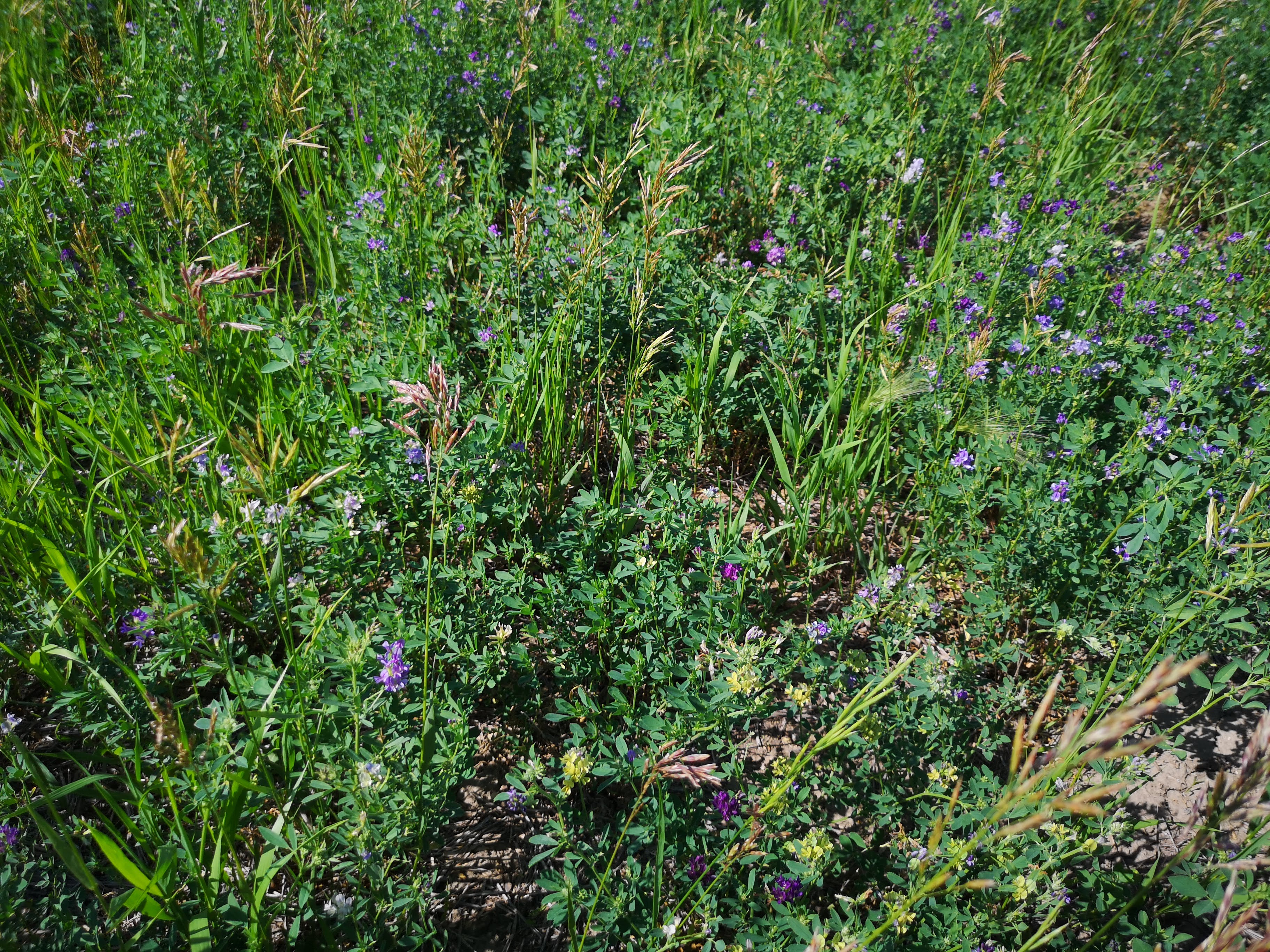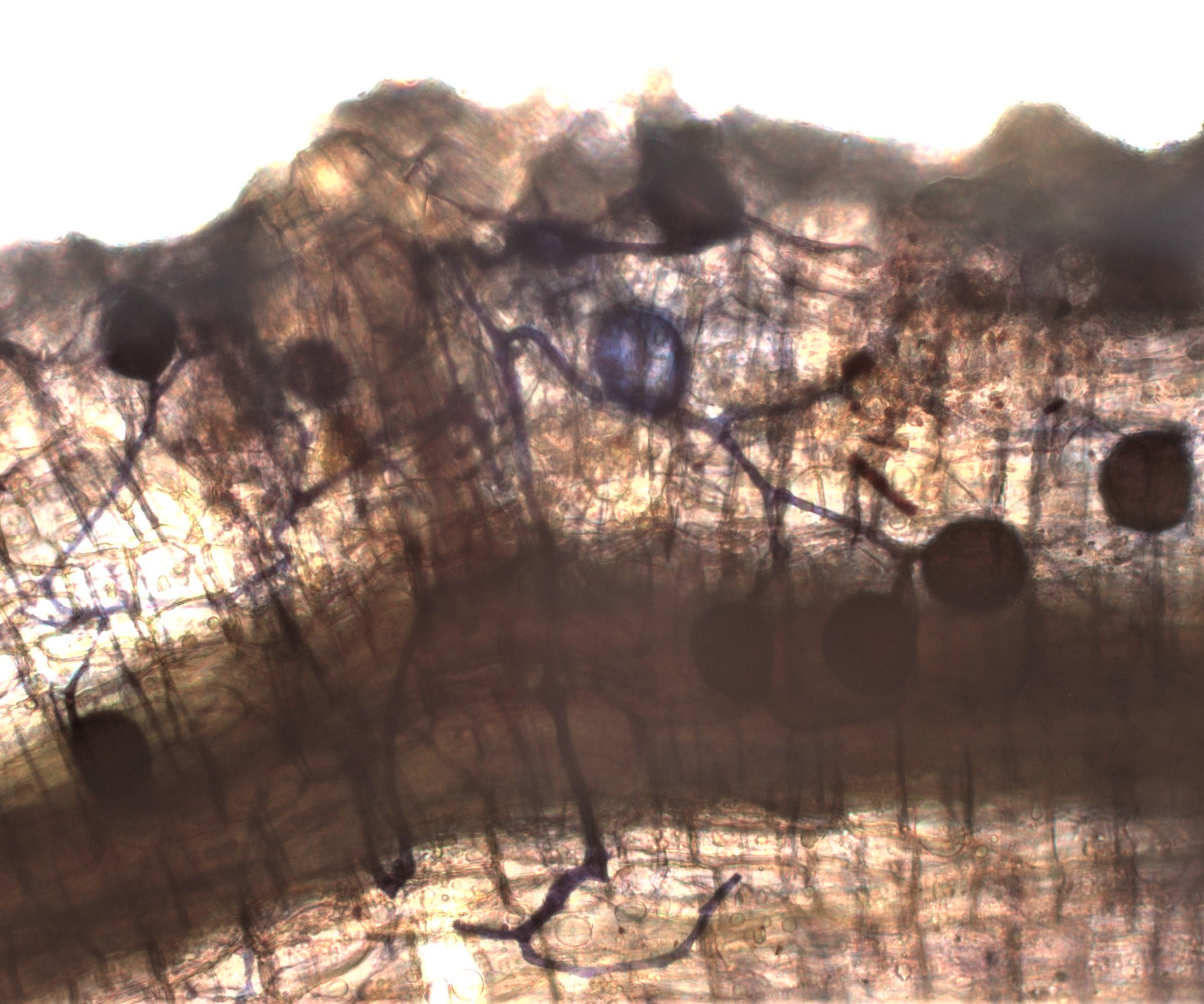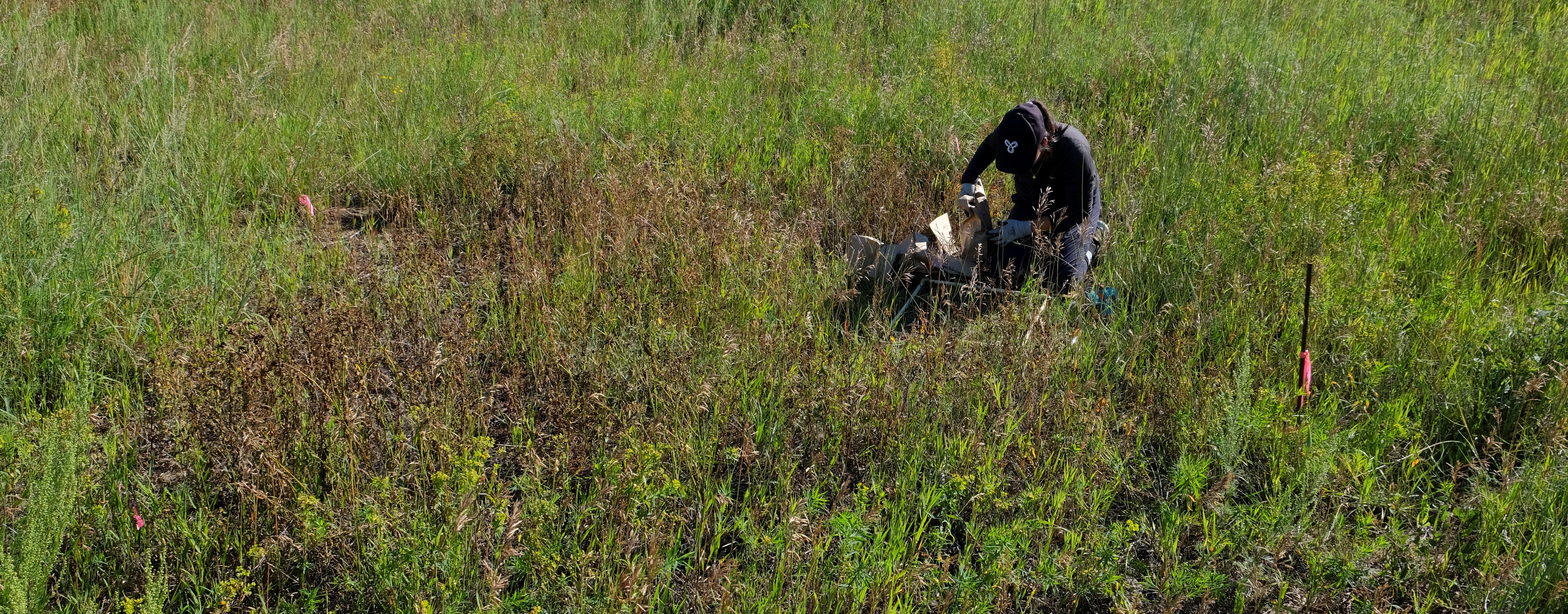Active projects
The productivity of forage stands frequently declines over time. Part of the reason for these declines may be the accumulation of soil organisms that are detrimental to plant health (negative plant-soil feedbacks); however, we know relatively little about how these feedbacks develop over time, especially in tame forage systems. This may be especially important for alfalfa (Medicago sativa) stands, as it is widely used but highly susceptible to many soil diseases. In collaboration with Drs. Bill Biligetu (U. Saskatchewan), Luke Bainard (AAFC), and Mike Schellenberg (AAFC), we conducted a survey of existing alfalfa pastures and a growth chamber experiemnt to determine how stand-age and complexity (monoculture or mixture) influence soil microbes and plant growth. Seeded plant diversity was a stronger predictor of soil microbial communities than stand age, with soil microbes having a more negative effect on plant growth in monoculture than mixture. Plant variety and species responses to the soil microbiome were highly variable, however. This project was led by former MSc student Stephen Awodele (and funded by the Saskatchewan Cattlemen’s Association and my NSERC Discovery Grant) and the first part was recently published in Agriculture, Ecosystems, and Environment. Stephen and I are currently using the data to test how variation in soil microbial communities can be linked to plant-soil feedbacks.
To follow up on this project, we received funding from the Beef Cattle Research Council to screen many more alfalfa varieties against soils from a large number of old alfalfa fields and will be updating ou results soon.

Absinth (Artemisia absinthium) is an invasive perennial plant that produces thousands of persistant seeds. It releases chemicals into the surrounding soil that inhibit the establishment and growth of native species, thus reducing forage production as it is not palatable to cattle. Consequently, it can be a problematic pasture and rangeland weed throughout western Canada but it can be difficult due to the large number of seeds produced and their longevity in the soil. We are working to understand absinthe invasion into rangelands and to develop ways of augmenting herbicide control. We recently published a paper in EcoScience led by John Paul Wasan showing that absinthe invasion requires strong disturbance in grasslands and that nutrient addition can improve biotic resistance, but also increases invasion following disturbance. We are now working to understand how plant composition and allelopathy alter biotic resistance and absinthe impacts.
We also have a new project looking at control of absinthe in perennial pasture, funded through the Saskatchewan ADF and the Sask. Cattlemen's Association. The basic idea is to find combinations of herbicides and fertilizers that can improve absinthe control while allowing for recovery of other broadleaf species, especially legume species that are critical to maintaining a healthy pasture.
Leafy spurge (Euphorbia esula) is an aggressive noxious weed that reduces the productivity and diversity of native rangelands. With a deep root system, aggressive clonal growth, and abundant seed production, it is difficult to control using traditional methods (e.g. manual removal, herbicides). Leafy spurge, however, appears highly reliant on mycorrhizal fungi for access to nutrients. In a project funded by the Saskatchewan Cattlemen’s Association and NSERC, we found that suppression of mycorrhizal fungi via fungicide improved leafy spurge control and increased grass abundances.
We have now received funding from the Saskatchewan Agriculture Development Fund to follow up on this work. With MSc student Sheila Taillon and PhD student Rebeca Teixera, we are tesing whether we can make the mycorrhizas parasitic by increasing the abundance of the nutrients they provide using different fertilizers. The hope is to develop leafy spurge control solutions that minimize the potential for herbicide resistance. At the same time, we are trying to understand how leafy spurge interacts with mycorrhizal fungi and the consequences of these interactions for invasion.

Most plants form symbioses with arbuscular mycorrhizal fungi (AMF), which provide plants with soil nutrients and can increase plant stress tolerance and disease resistance. Perennial forages are often grown in marginal land may benefit greatly from AMF as they are often exposed to increased disease pressure due to limited crop rotation, and water and salt stress are common in marginal lands. These benefits may be especially important for forage legumes as they are often phosphorus limited. Selecting for specific traits when breeding forages may select for or against symbioses with AMF, which could affect the vulnerability of these varieties to other stresses.
To test these ideas, MSc student Aisa Kuper-Psenicnik conducted a greenhouse experiment testing how commercial alfalfa varieties bred for different traits respond to commercial mycorrhizal inoculum under nutrient limitation, drought, and salt stress. PhD student Suma Ghosh has expanded on this work by determining whether we can identify alfalfa and sainfoin genotypes that are more mycorrhiza responsive (funded by the Alberta Beef Producers), and whether we can identify native AMF communities that are beneficial for different forages (funded by the Saskatchewan Cattlemen's Association). Thanks to funding from the NSERC Alliance program, Suma will also be working to identify what factors determine mycorrhizal responsiveness, be that the environment, the composition of the AMF community, or the traits of the plant.

We are expanding on our forage inoculation work to identify native microbes that can enhance salinity tolerance in barley. We have had some pretty good success with our initial trials, with some inocula tripling the size of barley plants grown in saline soil. In a project funded through Sask. ADF, the Manitoba Crop Alliance, SaskBarley, and WGRF, we are expanding on this work to find inocula that work for many barley varieties under a range of salinities and then to take those inocula for field trials. Exciting times ahead!
Typically, native species are not seeded into tame pasture because of seed costs and limited success. Native species, however, have many benefits that could improve the functioning of seeded forage stands. With this study, we are trying to determine what strategies, including different harvest intervals, can be used to ensure native species establishment into mixed pasture and the consequences for ecosystem function, focusing on forage production, carbon sequestration, and nutrient retention. From a more basic ecological perspective, we will also use this project to understand how species origin (i.e., native vs. non-native) affects biodiversity-ecosystem functioning relationships and the role of the soil microbiome in driving these relationships. MSc student Runli Yuan will be tackling the below ground functioning aspect of this experiment along with MSc student Yun Huang, who is working on how harvest frequency and plant diversity impacts soil microbial communities and plant-soil feedback. This project is funded by the Saskatchewan Agriculture Development Fund, Saskatchewan Cattlemen's Association, and the Saskatchewan Forage Seed Development Commission.
Other research interests
Mycorrhizas can have dramatic effects on plant growth and resource allocation, which can have subsequent effects on many plant-associated interactions (e.g. competition, herbivory, and pollination). Dr. Bennett has previously worked on how mycorrhizas affect competition and pollination within native grasslands, and is still interested in exploring the mechanisms of these interactions and their consequences for plant communities. Interested students should contact Dr. Bennett to develop projects.
Pollinators are undoubtedly important for plant reproduction, yet their role in structuring plant communities is less clear. This is especially true in perennial grasslands due to the prevalence of asexual reproduction (clonal growth) and high interannual variability in flowering among and within species. Environmental stressors (e.g. drought, eutrophication, overgrazing) can also alter both plant flowering and their interactions with pollinators, yet it is unclear how changes in these interactions will affect the structure of grassland plant communities. Although no projects in this area are currently planned, it remains an area of interest and students with similar interests are encouraged to contact Dr. Bennett.
Completed projects
Small ruminants (e.g. goats, sheep) eat many plants that cattle do not and can be effective in controlling many rangeland weeds. We worked with a local producer group to monitor the effectiveness of a long-term small ruminant grazing program designed to control leafy spurge. Under the umbrella of this project and other leafy spurge control projects, we tested for spurge effects on plant traits, grass productivity and nutritional content. This project was part of the undergraduate thesis of Erin Anderson and the USRA programs for Terava Groff and Catherine Liu and has been puclished in Neobiota.
Plant communities vary in their drought tolerance, yet it is unclear which aspects of the plant community drives this variation and how much of this variation is mediated by soil microbes. We leveraged a large-scale drought experiment conducted by multiple labs (Eric Lamb, U. Saskatchewan; Cameron Carlyle, U. Alberta; Mike Schellenberg, AAFC; Rafael Otfinowski, U Winnipeg) across the Canadian prairies to test how plant diversity and productivity modulated plant-soil feedback effects on drought tolerance. Soils from drought-stressed and untreated plots were used in a greenhouse experiment where we will test the effects of further drought on soil microbes and plant growth. In a recent paper led by undergraduate thesis student Seth Lundell and published in Ecology, we found that plant-soil feedbacks were most positive in less diverse and less productive communities but that the benefits from soils in less diverse communities disappeared following drought. This suggests that biodiversity loss may increase drought suscpetibility in Canadian grasslands.
Although this project is currently on hiatus, it is an area I would like the lab to continue working on.
Mycorrhizal fungi are important plant symbionts that can increase plant nutrient uptake and disease resistance, with profound consequences for the survival and growth of seedlings (plant-soil feedbacks). The benefits plants gain from mycorrhizas depend, however, on the type of mycorrhiza formed and the environment in which the interaction takes place. Trembling aspen (Populus tremuloides) forms both arbuscular and ectomycorrhizas, yet it is unclear whether natural environmental variation causes switching in the dominance of the mycorrhizal types or what the consequences of such switching would be for plant-soil feedbacks. We are currently exploring this question with Dr. Justine Karst (U. Alberta).
Under this framework, we examined how plant-soil feedbacks persist following tree death (legacy effects) no published in Plant and Soil and are interested in exploring the role in fungal community structure in these interactions.
Leafy spurge (Euphorbia esula) is an increasingly common noxious weed in pastures and rangelands throughout Saskatchewan and the rest of the northern Great Plains. The preferred control solution is to use herbicide to eradicate new leafy spurge populations before they become too large. Early eradication is rarely achieved, however, and control of established leafy spurge populations is considerably more challenging. Spurge can be partially controlled by the application of systemic herbicides with long soil residency times; however, even the application of these chemicals provides only temporary control and applications must still be repeated. Underappreciated risks of repeated herbicide application in rangeland could include reductions in range and soil health mediated by the reduction or loss of sensitive plant species (including some grasses and many legumes) and changes in the structure of the soil microbial community. These changes can result in reduced forage productivity and stability, increased weed establishment, and accelerated carbon and nitrogen losses from rangeland systems. Consequently, it is critical to understand the frequency with which herbicides can be applied to maintain both control of leafy spurge and essential rangeland functions.
To address this issue MSc student Erin Malis (co-supervised with Dr. Bobbi Helgason in Soil Science) applied herbicide at different frequencies and measure changes in leafy spurge densities, forage production, plant community composition, invasion by other weeds, soil microbial community composition, carbon storage, and nitrogen cycling. Erin found strong effects on the plant community, but limited herbicide effects on soil microbial communities (as measured with PLFAs). More details coming soon.


